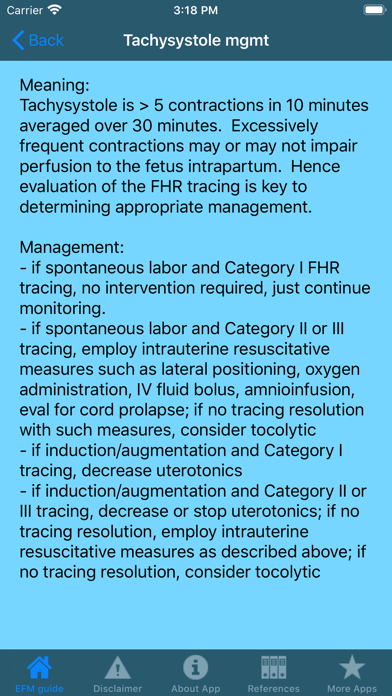
EFM Guide
teaching guide for trainees
Free
3.2for iPhone, iPod touch
8.9
2 Ratings
Joshua D. steinberg
Developer
2.5 MB
Size
May 1, 2020
Update Date
Medical
Category
17+
Age Rating
Age Rating
EFM Guide Screenshots
About EFM Guide
EFM Guide is a non-commercial quick-reference app for medical trainees (not the lay public). It puts at your fingertips the approach, nomenclature, and management recommendations from the guidelines on electronic fetal monitoring (EFM) from 2008, 2009, and 2010. Each EFM finding and tracing is defined and explained with pictures. Management responses for findings and category interpretations are presented. And the systematic approach to EFM evaluation is reviewed. This app is written and intended for resident & student physician trainees, for nursing and midwifery trainees, and for practicing clinicians. It answers questions such as the following:
- what is moderate baseline fetal heart rate variability?
- what are the differences between an early, variable, and late deceleration?
- what qualifies as tachysystole? and how can I manage tachysystole?
- if my patient is 31 weeks gestation, what counts as an acceleration?
- what qualifies as category I, II, and III tracings, and what does each suggest clinically?
- what are the elements of systematic EFM tracing evaluation?
- how may I respond to a category II tracing?
- what does sinusoidal pattern look like?
This guide tries to faithfully present the NICHD material for quick effective reference and review, it does not present the judgment of the app's authors. As educators and clinicians, we are interested in feedback and we would be grateful for guidance on improving the tool.
- what is moderate baseline fetal heart rate variability?
- what are the differences between an early, variable, and late deceleration?
- what qualifies as tachysystole? and how can I manage tachysystole?
- if my patient is 31 weeks gestation, what counts as an acceleration?
- what qualifies as category I, II, and III tracings, and what does each suggest clinically?
- what are the elements of systematic EFM tracing evaluation?
- how may I respond to a category II tracing?
- what does sinusoidal pattern look like?
This guide tries to faithfully present the NICHD material for quick effective reference and review, it does not present the judgment of the app's authors. As educators and clinicians, we are interested in feedback and we would be grateful for guidance on improving the tool.
Show More
What's New in the Latest Version 3.2
Last updated on May 1, 2020
Old Versions
links to more apps for clinicians, students, residents, and health professionals
Show More
Version History
3.2
May 1, 2020
links to more apps for clinicians, students, residents, and health professionals
3.1
Dec 9, 2014
updated for iOS 8 (thanks for being patient!)
3.0
Sep 29, 2011
The Nov. 2010 ACOG Practice Bulletin management of EFM tracings has been added, as well as more pictures and better pictures of tracings.
2.0
May 23, 2011
EFM tracings finally included!
1.0
Jun 24, 2010
EFM Guide FAQ
Click here to learn how to download EFM Guide in restricted country or region.
Check the following list to see the minimum requirements of EFM Guide.
iPhone
Requires iOS 13.0 or later.
iPod touch
Requires iOS 13.0 or later.
EFM Guide supports English





























